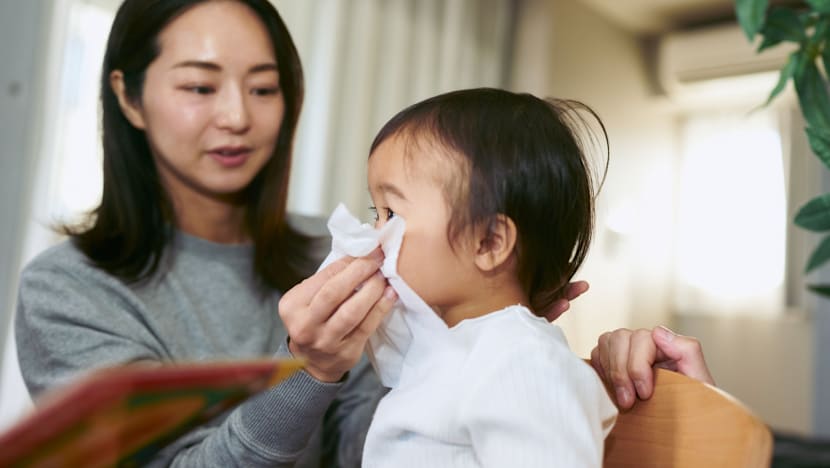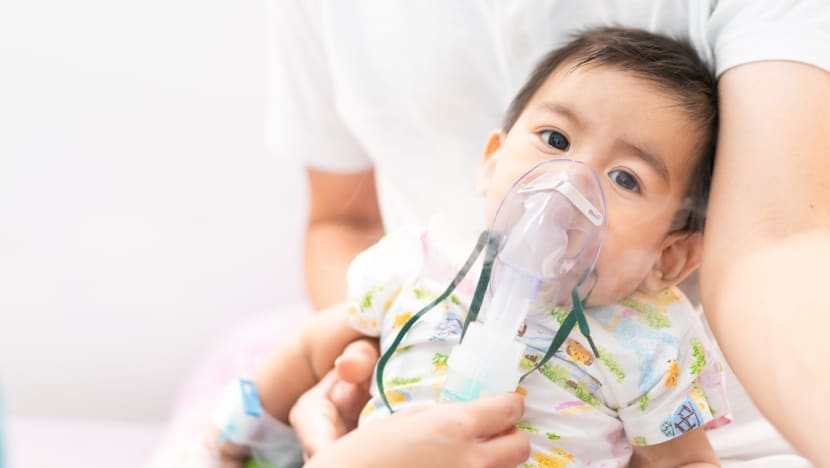Beyond the sniffles: Understanding RSV in infants
Respiratory syncytial virus is common in childhood, but in some infants, it can cause serious illness. Here’s how to spot the signs and keep your child safe.

A runny nose can be an early sign of a respiratory syncytial virus infection. Photos: Shutterstock, Sanofi

This audio is generated by an AI tool.
Every year, respiratory syncytial virus (RSV) quietly circulates among Singapore’s youngest residents – often disguised as a common cold1. But in infants, this seemingly minor illness can lead to serious complications that require hospital care.
RSV consistently ranks among the top paediatric viruses detected at local polyclinics in children treated for acute respiratory infections, according to data from the Communicable Diseases Agency (CDA).
Local research echoes this trend: A study published in Emerging Infectious Diseases found that RSV is a leading cause of hospital admissions for acute lower respiratory tract infections in young children in Singapore, particularly among infants under six months and toddlers up to 29 months2.
Globally, the World Health Organization (WHO) estimates that RSV causes more than 3.6 million hospitalisations and around 100,000 deaths each year in children under five.
WHAT RSV CAN LOOK LIKE
RSV is a respiratory virus that affects the airways and lungs. Video: Sanofi
RSV is highly contagious and spreads through droplets in the air when an infected person coughs or sneezes. While it usually causes mild symptoms in healthy older children and adults, it can trigger serious complications in infants – most commonly breathing difficulties that may require hospital care.
WHO reports that symptoms typically emerge within four to seven days after exposure. Early signs include runny nose, sore throat, headache, fatigue and fever. As the illness progresses, these may worsen to include coughing, shortness of breath, rapid breathing, wheezing and bronchospasm – tightening of the muscles around the airways.

Paediatric infectious diseases specialist Professor Juan Pablo Torres observed that in infants, RSV may present more subtly at first, like feeding less than usual.
“In the following days, they start having respiratory symptoms, especially cough,” he said. “Some of the more severe cases can develop polypnea, or rapid breathing, which may lead to respiratory failure. These infants may need hospitalisation, oxygen support, paediatric intensive care or even mechanical ventilation.”
THE WIDER IMPACT OF RSV ON INFANTS
Prof Torres, who practises at the Division of Paediatric Infectious Diseases at the Children’s Hospital Luis Calvo Mackenna in Santiago, Chile, noted that nearly all children worldwide are infected with RSV by the age of two – even healthy full-term infants are not exempt.
“We are dealing with a virus that is very common,” he explained. “Unlike some infections where attention is focused on high-risk groups, RSV often affects healthy infants. It is the main cause of bronchiolitis and pneumonia in this age group. Around 70 to 80 per cent of RSV-related hospitalisations involve infants with no underlying conditions.”
That said, some children face an even higher risk of complications, particularly those born prematurely or with congenital heart condition or chronic lung disease, Prof Torres added.
While most children recover fully, he cautioned that a more severe RSV infection may have longer-term effects. Around 20 to 30 per cent of affected infants may later develop asthma or airway hyper-reactivity.
TURNING THE TIDE ON RSV

After decades with limited preventive options, new developments are offering more ways to protect young children from RSV. In 2024, Chile became the first country in the Southern Hemisphere to implement a national RSV immunisation strategy3.
Over six months, the state-funded programme administered a single dose of a targeted monoclonal antibody immunisation to more than 150,000 infants under six months – from healthy full-term babies to those at higher risk, such as pre-term infants with congenital heart conditions.
Findings published in The Lancet Infectious Diseases3 reported an almost 80 per cent reduction in RSV-related hospitalisations and for the first time, no RSV-related deaths were recorded in children under the age of one, down from 13 the previous year.
In Singapore, experts have also highlighted the need for greater protection. A panel of paediatricians recently published an expert consensus4 underscoring the urgency of safeguarding all infants against RSV. They recommend that immunisation be considered for inclusion under the National Immunisation Programme to help reduce the RSV burden on the healthcare system.
With more immunisation options now available, these developments signal growing momentum to strengthen early defences against RSV. Prof Torres believes the key lies not only in medical advances but also in building public trust through education. Healthcare professionals play a vital role in sharing evidence-based information with families, he said.
Locally, hygiene practices remain a crucial line of defence. CDA recommends regular handwashing, wearing masks when unwell and avoiding close contact to reduce the spread of RSV. Parents are also encouraged to keep unwell children out of school or childcare settings to prevent further transmission.
As prevention tools continue to evolve, families and healthcare professionals now have more ways to protect vulnerable infants from RSV. “When it comes to RSV, early action, shared understanding and informed choices can make a meaningful difference,” said Prof Torres.
If you’re concerned about your infant’s health, speak to a healthcare professional to learn more about available preventive measures, including immunisation. Visit TogetherAgainstRSV.sg for more information.
1. Ali ST, Tam CC, Cowling BJ, Yeo KT, Yung CF. Sci Rep. 2020 Nov 24;10(1):20469. doi: 10.1038/s41598-020-76888-4
2. Tam CC, Yeo KT, Tee N, Lin R, Mak TM, Thoon KC, Jit M, Yung CF. Emerg Infect Dis. 2020 Jul;26(7):1489-1496. doi: 10.3201/eid2607.190539
3. Torres JP, Saure D, Goic M, Thraves C, Pacheco J, Burgos J, Trigo N, Del Solar F, Neira I, Diaz G, O’Ryan M, Basso LJ. Lancet Infect Dis. 2025 Jun 10:S1473-3099(25)00233-6. doi: 10.1016/S1473-3099(25)00233-6
4. Goh DYT, Goh A, Chen CK, Chan SM, Khoo PC, Thoon KC, Li J, Lee BW, Yung CF. World J Pediatr. 2025 Jun. doi: 10.1007/s12519-025-00926-2
MAT-SG-2500275-1.0-08/2025















